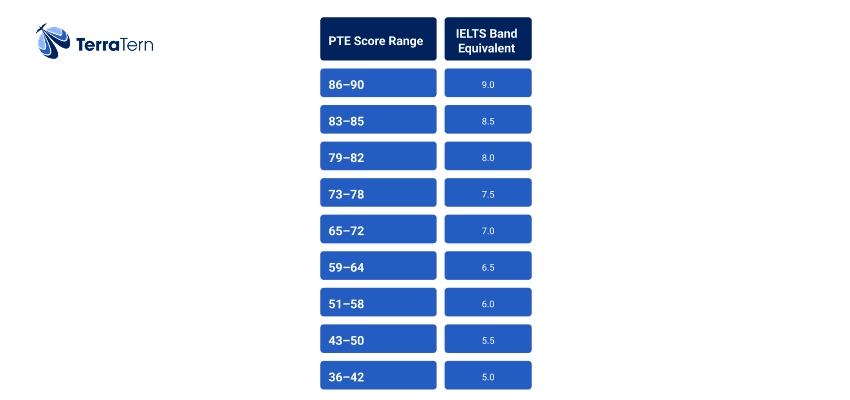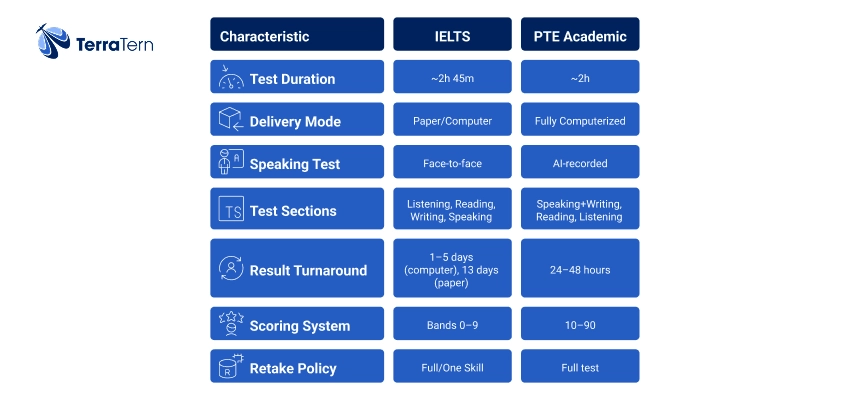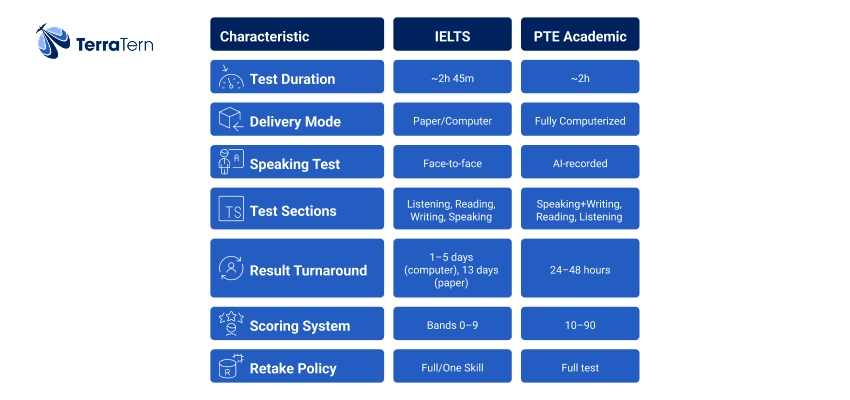Key Highlights
- Latest Facts & News (2025)
- What is PTE and IELTS Score Comparison? Overview, Purpose, and Global Acceptance in 2025
- PTE and IELTS Score Comparison Systems Explained: Experts Update 2025
- Official PTE and IELTS Score Comparison Tables (2025)
- Deep Dive: How Scores Are Calculated and What They Mean?
- Section-Wise Comparison: Listening, Reading, Writing, Speaking (PTE vs IELTS) in 2025
- Latest Test Format, Timing, and Experience: What to Expect in 2025?
- Score Requirements for Study, Work, and Immigration (2025 Update)
- Latest Factors to Consider When Choosing Between PTE and IELTS in 2025
- How to Prepare for Your Target Score? Experts Advanced Strategies in 2025
- Real-World Scenarios: Case Studies & Score Interpretation: Experts Insights 2025
- Common Mistakes in PTE and IELTS Score Interpretation in 2025
- Conclusion
Understanding the difference between PTE and IELTS score can be difficult for candidates, but it's crucial for them if they are planning to study abroad, work, or migrate. Both exams analyze English language proficiency, but their formats differ, as do their scoring systems and recognition.
This 2025 guide on PTE and IELTS score provides detailed score charts conversion, band equivalence with an expert guide, which will help candidates to make an informed decision while choosing between these exams.
Latest Facts & News (2025)
-
IELTS and PTE both updated their scoring concordance tables in 2025, impacting university and immigration requirements.
-
PTE’s AI-driven scoring now includes periodic human audits for speaking and writing, increasing reliability.
-
IELTS introduced enhanced digital security for computer-based tests, reducing incidents of impersonation.
-
Australia and Canada now accept both PTE and IELTS for all major visa streams, but minimum score requirements differ.
-
IELTS “One Skill Retake” is now available in more countries, letting test-takers improve individual section scores.
-
The PTE Academic test duration was reduced by 10 minutes in 2025, making it the fastest mainstream English proficiency test.
-
IELTS remains the only test with a fully human-assessed speaking section.
-
Universities in the UK, the US, and Australia now publish separate PTE and IELTS score requirements for each major.
-
PTE and IELTS test fees increased by 5–8% globally in early 2025.
-
More than 80% of surveyed students in 2025 found PTE’s integrated tasks more challenging than IELTS’s section-based format.
Also Read: IELTS Exam Syllabus: Latest Exam Guide & Updates
What is PTE and IELTS Score Comparison? Overview, Purpose, and Global Acceptance in 2025

PTE and IELTS score are two of the most widely accepted English language proficiency tests used around the world for higher education, skilled migration, and professional opportunities. They serve as trusted indicators of a candidate’s ability to use English in academic, workplace, and social settings, and are essential for those planning to live, study, or work in English-speaking countries.
The PTE (Pearson Test of English Academic) is a fully computer-based exam developed by Pearson. It uses AI-powered scoring to deliver highly objective and quick results, usually within 24 to 48 hours. Its format is designed to reflect real-life academic and workplace English, making it a popular choice for tech-savvy test takers who prefer automated testing experiences.
On the other hand, the IELTS (International English Language Testing System) is jointly owned by the British Council, IDP: IELTS Australia, and Cambridge University Press & Assessment. It offers two modes, paper-based and computer-delivered, and features a face-to-face speaking test with a human examiner, which many test-takers find more personal and natural.
Both PTE and IELTS score are accepted by over 11,000 organizations worldwide, including top universities, immigration authorities, and professional bodies in countries such as Australia, Canada, the UK, the USA, New Zealand, and several European and Asian destinations. For students applying to international universities, skilled workers applying for permanent residency, or professionals seeking licensure abroad, these tests are critical credentials.
PTE and IELTS Score Comparison Systems Explained: Experts Update 2025

Understanding the difference between IELTS and PTE score systems is essential for choosing the right test and accurately interpreting your results. Although both exams assess the same core language skills, Listening, Reading, Writing, and Speaking, they use very different methods to evaluate and report your English proficiency.
IELTS Score System: Human-Graded Bands (0–9)
The IELTS scoring system is based on a 9-band scale, with scores ranging from 0 (non-user) to 9 (expert user). Each of the four sections is graded individually by trained human examiners, and the final score is the average of the four section scores. Scores are reported in whole or half-band increments (e.g., 6.5, 7.0, 7.5).
-
Band 9: Expert user
-
Band 7: Good user
-
Band 6: Competent user
-
Band 5: Modest user
This human examiner-based model allows for contextual and qualitative judgment, particularly in the Speaking and Writing sections.
PTE Score System: AI-Driven Scoring (10–90 Scale)
In contrast, the PTE Academic uses a computerized scoring system that ranges from 10 to 90. It relies on artificial intelligence (AI) to ensure fast, objective, and consistent scoring. PTE also includes human audit layers in newer versions to improve accuracy, especially in open-response tasks.
-
Scores are calculated using a combination of correct responses, fluency, pronunciation, and grammar.
-
PTE is fully computer-based, including Speaking, which uses voice recognition software to evaluate pronunciation and fluency.
Also Read: Documents Required for IELTS Exam: Latest Checklist
Official PTE and IELTS Score Comparison Tables (2025)

When choosing the difference between IELTS and PTE score, it's essential to understand how scores from each test align. Although both are accepted by thousands of institutions worldwide, their scoring systems are fundamentally different, making direct conversion complex and sometimes inaccurate. Still, official concordance studies and data released by Pearson and other research-backed sources provide a reliable basis for PTE and IELTS score comparison.
This section presents the latest 2025 PTE and IELTS score comparison tables, highlighting both overall and skill-specific equivalencies. These comparisons are crucial for applicants submitting scores for study, work, or migration purposes in countries like Australia, Canada, the UK, and the US.

Why Score Conversion Is Not One-to-One?
A direct, one-to-one comparison of PTE and IELTS score isn't always possible because:
-
IELTS uses human-examiner band scores (0–9) in half-band steps.
-
PTE uses a granular AI-driven scale from 10 to 90, which evaluates micro-skills like fluency and grammar more precisely.
-
Skill-specific performance may vary between tests due to format differences.
|
IELTS Band |
Listening |
Reading |
Speaking |
Writing |
|
5.0 |
40 |
43 |
40 |
43 |
|
6.0 |
48 |
54 |
46 |
62 |
|
7.0 |
66 |
68 |
65 |
82 |
|
8.0 |
78 |
78 |
81 |
89 |
These tables are based on the latest 2025 PTE and IELTS score comparison concordance research, ensuring high accuracy for academic and immigration applications. Understanding the difference between IELTS and PTE score comparison can help you plan more effectively, whether you're targeting university admissions, permanent residency, or licensing exams.
Deep Dive: How Scores Are Calculated and What They Mean?

Understanding how your scores are calculated in PTE and IELTS score is just as important as knowing the results themselves. The comparison of IELTS and PTE score systems goes beyond just scale; it's rooted in how each test evaluates your language ability, the tools used, and the criteria applied.
IELTS Scoring: Human-Centric, Band-Based Evaluation
IELTS uses a 0 to 9 band score system, where each skill, Listening, Reading, Writing, and Speaking, is graded individually by trained human examiners. The final overall score is the average of the four section scores, reported in whole or half-band increments (e.g., 6.5, 7.0, 7.5).
1. Scoring Criteria
-
Listening & Reading: Based on the number of correct answers (out of 40).
-
Writing & Speaking: Assessed using four criteria each:
Writing: Task achievement, coherence & cohesion, lexical resource, grammatical range & accuracy
Speaking: Fluency & coherence, lexical resource, grammatical range & accuracy, pronunciation
What the Bands Mean (in real terms):
-
Band 6.0: Competent user – may make errors but can understand and communicate in familiar situations.
-
Band 7.0: Good user – handles complex language well but with occasional inaccuracies.
-
Band 8.0+: Very good to expert user – fluent, accurate, and well-structured communication.

Integrated Skills and Real-World Impact
A unique aspect of PTE is its integrated skill approach. For example, your Speaking score can be affected by your ability to write and summarize spoken texts. This offers a more holistic view of language use, but it also means weaknesses in one area may influence multiple scores.
In contrast, IELTS scores are compartmentalized, meaning one weak skill (e.g., Speaking) won’t lower another (e.g., Reading), offering more transparency for those looking to improve specific areas.
CEFR Alignment and Institutional Use
Both IELTS and PTE align with the Common European Framework of Reference (CEFR), a global benchmark for language proficiency. For example:
-
IELTS 6.5 / PTE 58–64 = CEFR B2
-
IELTS 7.5 / PTE 73–78 = CEFR C1
Universities and immigration bodies interpret scores differently. Some may accept a lower Writing score, while others require consistent performance across all skills. Understanding the difference between IELTS and PTE score is critical when planning your test strategy.
Also Read: How Can I Prepare for IELTS at Home? Latest Guide
Section-Wise Comparison: Listening, Reading, Writing, Speaking (PTE vs IELTS) in 2025

A clear comparison of PTE and IELTS score section-wise helps you understand the structure, scoring, and strategies for each skill. Below is the rephrased breakdown comparison of pte and IELTS score:
-
Listening
IELTS Listening:
- Format: 4 audio sections, 40 questions.
- Duration: 30 minutes + 10 minutes for answer transfer.
- Scoring: Human-marked, band scale (0–9).
- Features: Involves lectures, conversations, and monologues.
- Tip: Focus on spelling, grammar, and fast-paced note-taking.
PTE Listening:
- Format: Multiple integrated tasks (e.g., summarize spoken text).
- Duration: 30–35 minutes.
- Scoring: AI-scored, scale (10–90).
- Features: Tasks often test multiple skills.
- Tip: Practice audio comprehension and typing simultaneously.
Reading
1. IELTS Reading:
- Format: 3 long texts, 40 questions.
- Duration: 60 minutes.
- Scoring: Human-marked, band scale.
- Features: Academic and General versions available.
- Tip: Use skimming and scanning to save time.
2. PTE Reading:
- Format: Fill-in-the-blanks, multiple choice, reordering.
- Duration: 30–40 minutes.
- Scoring: AI-based, 10–90 scale.
- Features: Some questions are integrated with writing.
Writing
1. IELTS Writing:
- Format: 2 tasks (Task 1: Graph/Letter, Task 2: Essay).
- Duration: 60 minutes.
- Scoring: Human-assessed using 4 criteria.
- Features: Evaluates coherence, grammar, and task achievement.
2. PTE Writing:
- Format: Summarize written/spoken text + essay writing.
- Duration: 40 minutes.
- Scoring: AI-based with human audit layers (2025 updates).
- Features: Integrated tasks, grammar- and fluency-focused.
Speaking
1. IELTS Speaking:
- Format: Face-to-face interview (3 parts).
- Duration: 11–14 minutes.
- Scoring: Human examiner, band scale.
- Features: Real-time interaction, spontaneous dialogue.
2. PTE Speaking:
- Format: Recorded responses using a microphone.
- Duration: 30–35 minutes.
- Scoring: AI-based, evaluates pronunciation and fluency.
- Features: Tasks include reading aloud, repeating sentences, etc.
Also Read: IELTS Score for Germany: Work & Study Requirements
Latest Test Format, Timing, and Experience: What to Expect in 2025?

When choosing PTE and IELTS score, it’s important to understand what the test day experience looks like, from duration and delivery modes to task structure. While both tests assess the same core skills, their formats, timings, and experiences differ significantly. This section explores the difference between and comparison of IELTS and PTE score delivery and testing format, helping you make an informed decision.
IELTS: Human-Touched, Multi-Mode Format
1. Duration: 2 hours 45 minutes (Listening, Reading, Writing in one sitting).
2. Speaking Test: Conducted separately, often on a different day.
3. Delivery Modes:
- Paper-based: Traditional method with handwritten responses.
- Computer-based: Faster results; available in select centers.
4. Experience:
- Requires interaction with a human examiner during the Speaking test.
- Ideal for candidates who prefer in-person communication and traditional setups.
PTE: Fully Computerized and Streamlined
- Duration: Approximately 2 hours.
- All Sections: Completed in a single sitting, including Speaking (via microphone).
- Delivery Mode: 100% computer-based; automated scoring system.
- Experience:
- Speaking is recorded and AI-evaluated—no human interaction.
- Fast and efficient; results are typically delivered within 24–48 hours.
- Suits tech-savvy candidates comfortable with digital interfaces.
Test Format Comparison Table
|
Feature |
IELTS |
PTE Academic |
|
Test Duration |
2 hours 45 minutes |
Approx. 2 hours |
|
Delivery Mode |
Paper-based or Computer-based |
Fully computer-based |
|
Speaking Test Format |
Face-to-face with a human examiner |
Recorded via computer and AI-scored |
|
Speaking Schedule |
Maybe on a different day |
Conducted on the same day |
|
Scoring System |
Band scale (0–9), human-assessed |
Scale (10–90), AI-driven with audit layers |
Score Requirements for Study, Work, and Immigration (2025 Update)

Understanding English language test score requirements is essential for international students, skilled migrants, and professionals aiming to study, work, or settle abroad. The most commonly accepted tests and comparison of IELTS and PTE score are used by top destinations like Australia, Canada, the UK, and the US to assess language proficiency. Here's a comprehensive overview of the PTE and IELTS score updated 2025 requirements for visas, permanent residency (PR), and institutional admissions.
-
Australia
Student Visa (Subclass 500)
-
IELTS: Minimum 6.0 overall (no band <5.5); PG courses may require 6.5+
-
PTE: Minimum 50; lower scores (36–49) accepted with ELICOS course
-
Changes (2025):
- Introduction of One Skill Retake for IELTS
- A growing number of universities now accept PTE Core and Academic
Work & PR (Subclass 189/190/491)
1. IELTS:
- Competent English: 6.0 (no PR points)
- Proficient: 7.0 (+10 PR points)
- Superior: 8.0 (+20 PR points)
2. PTE:
- Competent: 50, Proficient: 65, Superior: 79+
-
Canada
Student Visa (SDS & Non-SDS)
1. IELTS (Academic): Minimum 6.0 in all bands (SDS route)
2. PTE:
- Officially accepted from 2024
- Minimum 60–65 (UG/PG), varies by institution
Work & PR (Express Entry)
1. IELTS (General): CLB 7 = 6.0 (min for Federal Skilled Worker)
2. PTE Core:
- CLB 7 = PTE 60–65
- Fully accepted by IRCC from late 2023

-
United Kingdom
Student Visa (Tier 4)
-
IELTS UKVI: 5.5 overall (for degree-level); higher for competitive programs
-
PTE Academic: Widely accepted; 59–65 minimum for most UG/PG courses
Work Visa & PR
-
IELTS (General): Minimum B1 (4.0) for lower-skilled, C1 (7.0) for skilled occupations
-
PTE: Accepted by some employers; score equivalent required
-
United States
Student Visa (F1)
-
IELTS: 6.0–6.5 (varies by institution/program)
-
PTE: Accepted by over 1,000 institutions; 50–65 commonly required
Work & PR (H-1B/Green Card)
1. No fixed score required by USCIS, but employers often expect:
- IELTS: 6.5–7.0
- PTE: 60–70 for professional roles
Also Read: How Many PTE Scores Are Required for a Canada Student Visa? Get the Answers Here!
Latest Factors to Consider When Choosing Between PTE and IELTS in 2025

Choosing the right English proficiency test is a critical decision for students, job seekers, and migrants. While both PTE and IELTS score are widely accepted across top destinations like Australia, Canada, the UK, and the US, they differ in format, delivery, scoring, and experience. Below is a complete guide of PTE and IELTS score to help you make an informed choice.
1. Test Format and Delivery Mode
-
IELTS: Offers both paper-based and computer-based formats. Speaking is face-to-face with an examiner.
-
PTE: Fully computer-based with AI evaluating all sections, including speaking.
If you’re uncomfortable speaking to a human examiner, PTE may suit you better. If you prefer human interaction, IELTS is ideal.
2. Result Turnaround Time
-
PTE: Results are typically available within 24 to 48 hours.
-
IELTS:
Computer-based: 3–5 days
Paper-based: 13 days
For urgent admissions or visa applications, PTE offers faster processing.
3. Score Requirements for Your Target Country or Institution
-
Some countries or institutions may prefer or require IELTS (e.g., IELTS UKVI for UK visas).
-
PTE is now accepted for Canada PR, Australia PR, and by thousands of universities worldwide.
Always check the exact score requirement and accepted tests of your destination.
4. Scoring and Evaluation
-
IELTS: Human examiners evaluate Speaking and Writing.
-
PTE: Entirely AI-scored, including speaking pronunciation, and fluency.
If you speak with an accent or struggle with AI evaluation, IELTS might be more forgiving.
5. Test Day Experience
-
IELTS: The Speaking test is on a separate day (in some centers).
-
PTE: All sections are completed on the same day in a single sitting.
How to Prepare for Your Target Score? Experts Advanced Strategies in 2025
Achieving your desired band score in the IELTS requires more than just basic preparation. Whether you're aiming for overall excellence or looking to improve a specific skill, these advanced strategies will help you get closer to your goal.
Understand Your Score Conversion
Before you begin, analyze how IELTS scores are calculated across Listening, Reading, Writing, and Speaking. Use official IELTS band descriptors to understand how your performance translates into scores.
Tip: Map out your current practice scores and identify which section needs the most improvement.
Use Official IELTS Practice Tests
Official resources are the most reliable way to benchmark your performance. They simulate real exam conditions and give you a clearer picture of where you stand.
-
Try the IELTS Official Practice Materials
-
Use the IELTS Prep App for mobile-friendly practice
-
Take full-length, timed mock tests weekly
Leverage the IELTS One Skill Retake (OSR)
If you didn’t meet your target in just one skill area, the IELTS One Skill Retake option allows you to retake only that module, saving you time and stress.
-
Ideal for candidates who narrowly missed their score in Writing or Speaking
-
Available at select test centers—check OSR availability
Integrated vs. Isolated Skills Practice
Integrated Approach:
Practice real-world communication skills that combine reading, writing, listening, and speaking. For example, listen to a podcast and summarize it in writing, then discuss it with a speaking partner.
Isolated Approach:
Target individual skills with focused drills:
-
Grammar and vocabulary for Writing
-
Accent recognition for Listening
-
Fluency and pronunciation for Speaking
-
Skimming and scanning for Reading
Also Read: IELTS Band Score Table: New Academic & Listening Guide
Real-World Scenarios: Case Studies & Score Interpretation: Experts Insights 2025
Understanding how PTE and IELTS score compare in actual application scenarios can help you make better decisions for study, migration, or career plans. Below are real-world case studies that illustrate how score conversions impact outcomes, including visa success and university admissions of PTE and IELTS score.
Case Study 1: University Admission – Balanced Scores
Applicant Profile:
-
Name: Aisha (India)
-
Goal: Admission to a UK Master's program
-
PTE Score: Overall 67 (L: 70, R: 65, S: 64, W: 68)
-
IELTS Equivalent: Overall 7.0 (L: 7.5, R: 6.5, S: 6.5, W: 7.0)
Outcome: Accepted
-
The university required an IELTS 6.5 overall with no band less than 6.0.
-
Aisha submitted her PTE score using the official PTE to IELTS score comparison chart and met all requirements.
Case Study 2: Visa Denial – High Overall, Low Sub-score
Applicant Profile:
-
Name: Zubair (Pakistan)
-
Goal: Australian PR (Skilled Migration)
-
PTE Score: Overall 79 (L: 84, R: 82, S: 57, W: 78)
-
IELTS Equivalent: Overall 8.0, but Speaking = 6.5 equivalent
Outcome: Visa delayed
-
Despite a strong overall score, his low Speaking score did not meet the minimum threshold for “Proficient English” (requires 65+ in each skill).
-
He was advised to retake only Speaking via IELTS for better sub-score control.
Case Study 3: Strategic Test Switch – IELTS to PTE
Applicant Profile:
-
Name: Daniel (Nigeria)
-
Attempt 1 (IELTS): Overall 6.5 (L: 6.5, R: 6.5, S: 6.0, W: 5.5)
-
Attempt 2 (PTE): Overall 63 (L: 65, R: 66, S: 60, W: 61)
-
IELTS Equivalent (PTE): Overall 6.5 equivalent with all bands 6.0+
Outcome: Accepted into an Australian university
-
Daniel struggled with IELTS Writing, so he switched to PTE for more consistent performance with automated scoring.
Common Mistakes in PTE and IELTS Score Interpretation in 2025
Understanding the comparison of pte and IELTS score is essential for accurate application planning. Many candidates and even institutions misinterpret conversions, which can lead to rejections or delays.
Mistake 1: Relying on Overall Score Only
Many students compare only the overall score without considering sectional minimums.
-
Why It’s Wrong: Universities and immigration bodies often require minimum scores in each skill (Listening, Reading, Writing, Speaking).
-
Fix It: Always review the breakdown and use the official PTE–IELTS conversion chart for individual skills.
Mistake 2: Using Unofficial Score Conversion Tables
Numerous third-party websites offer misleading or outdated comparison charts.
-
Why It’s Wrong: These may not align with current academic or immigration standards.
-
Fix It: Refer only to official sources from IELTS and PTE websites for accurate equivalencies.
Mistake 3: Assuming Test Format Doesn’t Affect Performance
Some candidates switch tests without understanding the test format differences, which can impact scores.
-
Example: IELTS Writing is human-evaluated, while PTE is AI-scored. Your writing style may perform differently across platforms.
-
Fix It: Practice with full-length mock tests for both exams before deciding which suits you best.
Mistake 4: Misinterpreting PTE Automated Scores
PTE scores are consistent but may undervalue pronunciation or intonation if not trained with algorithm-friendly patterns.
-
Why It Matters: A native speaker may still score low on Speaking due to technical delivery issues.
-
Fix It: Use PTE-specific speaking practice tools and record your responses for self-evaluation.
Mistake 5: Overlooking Institutional Interpretation Variance
Not all universities or visa offices interpret PTE and IELTS score equivalently.
-
Why It’s Risky: Some institutions may still prefer IELTS for face-to-face speaking or visa applications, especially in Canada or the UK.
-
Fix It: Always check with your target institution or immigration authority before finalizing your test.
Also Read: IELTS Advantage Disadvantage Essay: Structure, Tips
Conclusion
Navigating the PTE and IELTS score interpretations is critical for achieving your academic or immigration goals. While both tests are widely accepted, understanding their format differences, scoring logic, and sectional requirements can make or break your application. To learn more about the PTE and IELTS score, visit TerraTern now.






